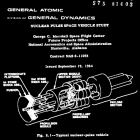 A report prepared by the Future Projects Office of NASA’s Marshall Spaceflight Center and General Atomic, the nuclear power division of General Dynamics, outlines in great detail ways that existing rocket technology (namely the Saturn V, which will not fly until 1967) and theoretical nuclear pulse propulsion technology could be combined to facilitate exploration of the moon and Mars. (Though derived from the Project Orion studies of the late 1950s, the potential nuclear-powered NASA program suggested in this document is not referred to as Orion.) The report, over 174 pages, goes into great detail about crew module design, radiation exposure, ways to mitigate the inevitable ablation of the “pusher plate” at the rear of the vehicle that will absorb a series of nuclear explosions at close range and translate the energy released into forward thrust, and even possible catastrophic launch abort modes, many of which would qualify as at least a small nuclear disaster. Even the health effects on civilian onlookers of a successful launch are considered, from retinal damage caused by viewing high-altitude firings of the nuclear propellant explosions to fallout risks, as well as potential collateral damage to satellites and non-hardened computers resulting from repeated electromagnetic pulses. The mission profiles considered are constrained to lunar missions and missions to Mars. (It’s worth noting that, by the time of this report’s issuance, the Nuclear Test Ban Treaty has been ratified by both the U.S. and the U.S.S.R., making it illegal to put nuclear pulse propulsion into practice.)
A report prepared by the Future Projects Office of NASA’s Marshall Spaceflight Center and General Atomic, the nuclear power division of General Dynamics, outlines in great detail ways that existing rocket technology (namely the Saturn V, which will not fly until 1967) and theoretical nuclear pulse propulsion technology could be combined to facilitate exploration of the moon and Mars. (Though derived from the Project Orion studies of the late 1950s, the potential nuclear-powered NASA program suggested in this document is not referred to as Orion.) The report, over 174 pages, goes into great detail about crew module design, radiation exposure, ways to mitigate the inevitable ablation of the “pusher plate” at the rear of the vehicle that will absorb a series of nuclear explosions at close range and translate the energy released into forward thrust, and even possible catastrophic launch abort modes, many of which would qualify as at least a small nuclear disaster. Even the health effects on civilian onlookers of a successful launch are considered, from retinal damage caused by viewing high-altitude firings of the nuclear propellant explosions to fallout risks, as well as potential collateral damage to satellites and non-hardened computers resulting from repeated electromagnetic pulses. The mission profiles considered are constrained to lunar missions and missions to Mars. (It’s worth noting that, by the time of this report’s issuance, the Nuclear Test Ban Treaty has been ratified by both the U.S. and the U.S.S.R., making it illegal to put nuclear pulse propulsion into practice.)
Tags:
Categories
Comments are closed